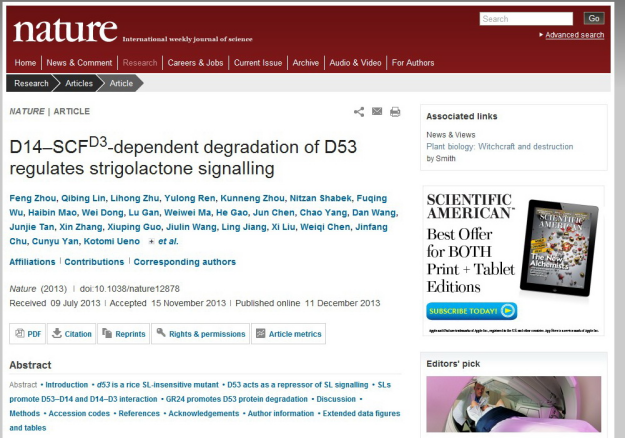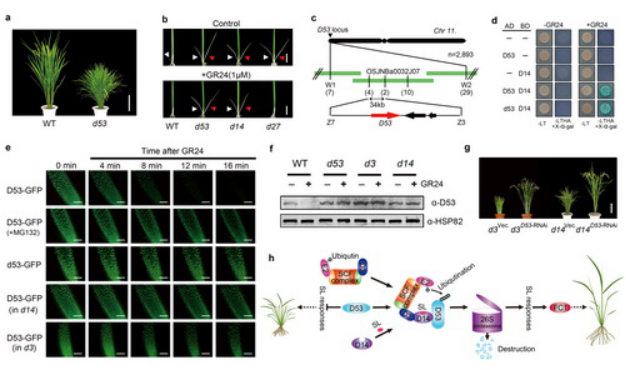The scientists of the Wan Jianmin team have made a breakthrough in research on signal transduction of hormones in regulating tillering in rice, and finding was published in Nature as Research Article on December 11 under the title of D14–SCFD3-dependent degradation of D53 regulates strigolactone signaling (doi:10.1038/nature12878, http://www.nature.com/nature/journal/vaop/ncurrent/full/nature12878.html) The study was the first to have confirmed genetically and biochemically that the D53 protein works as an inhibitor of the signal pathway of strigolactone and joins in regulating tillering of plants, and the paper was first one contributed by NAU authors to the journal of Nature and also one of the few research articles in the journal by Chinese authors in the field of plant science. Nanjing Agricultural University is listed as the first affiliation under the authors, the Ph. D candidate Zhou Feng of the College of Agronomy of the university is the first author and Professor Wan Jianmin is the correspondence author.

The application of heterosis in rice is regarded as the second green revolution, but it rather hard to further raise the per unit area yield of indica rice. Effective utilization of the strong heterosis between indica and japonica subspecies in rice may realize the yield increase again. However, the general problem of the hybrid plant being taller than its parent plant and some other problems seriously limits the employment of heterosis between indica and japonica subspecies. This problem may be solved by making use of the dominant dwarfing gene in the rice plant. Meanwhile, tillers and height are considered to be the major components of plant type of rice and are also the determine factors of hybrid rice yield. Therefore, Professor Wan and colleagues have chosen tillering, part of the dominant short stem and ideal plant type as perspectives of exploration into rice plant improvement.
Previous studies showed that endogenous hormones play a critical role in regulating growth and development of plant tillers. In 2008, at the same time, two research teams reported to have found a new hormone strigolactone that regulated plant tillering, updating the previous theory of two hormones (auxin and cytokinin) regulating plant stem tillering. Many researches prove that synthesis of strigolactone may arise from the pathway of catotene, but little is known about its signaling pathway.
The NAU research team led by Professor Wan Jianmin used a partly dominant dwarfing multi-tiller mutant (offered by Kyushu University of Japan) and named it dwarf 53 (d53). They examined d53 by exogenous and endogenous hormone treatment and identified it to be an insensitive mutant. By fine mapping and map-based cloning, they isolated the D53 gene at the end of the No. 5 chromosome of rice. The gene encoded a new nucleoprotein structurally similar to type I Clp ATPase. The following function analysis showed that, under the existence of strigolactone, D53 might interacted with two known signaling molecules, D13 and D3, formed a D53-D14-SCFD3 compound. D53 was ubiquitylated here, and specifically degraded by the proteasome system, and finally induced the expression of the downstream target gene and the signaling response of strigolactone. This conclusion was echoed by the researchers of the team led by Professor Li Jiaxiang, academician of Chinese Academy of Sciences, who used another dwarfing multi-tiller mutant of rice e9 in a related study and reached similar conclusion. The research result of the Wan’s team published in the journal of Nature.

This is a new breakthrough by the Wan’s team in illustrating the mechanism of plant tillering following their previous conclusion of the TE protein regulating rice tillering published in Nature Communications in 2012, which not only provided theoretical support for improvement of plant type in rice, but also supplied material for employing the heterosis between indica and japonica subspecies.
This research was completed by cooperation with the Institute of Crop Science of Chinese Academy of Agricultural Sciences, and in the later phase with University of Washington of USA, the National Research Center of Plant Genes of Beijing and University of Tokyo of Japan, and was sponsored by the funds of the National Major Transgenic Program, the National "863" Program, the National Natural Science Foundation of China and the Jiang Province "333" Talent Project.






